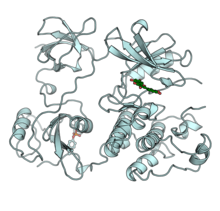Protein tyrosine-kinase
| Protein tyrosine kinase | |||||||||
|---|---|---|---|---|---|---|---|---|---|

pdb 2HCK, rendered in PyMOL
|
|||||||||
| Identifiers | |||||||||
| Symbol | Pkinase_Tyr | ||||||||
| Pfam | PF07714 | ||||||||
| InterPro | IPR001245 | ||||||||
| SMART | TyrKc | ||||||||
| PROSITE | PDOC00629 | ||||||||
| SCOP | 1apm | ||||||||
| SUPERFAMILY | 1apm | ||||||||
| OPM superfamily | 207 | ||||||||
| OPM protein | 2k1k | ||||||||
| CDD | cd00192 | ||||||||
|
|||||||||
| Available protein structures: | |
|---|---|
| Pfam | structures |
| PDB | RCSB PDB; PDBe; PDBj |
| PDBsum | structure summary |
A tyrosine kinase is an enzyme that can transfer a phosphate group from ATP to a protein in a cell. It functions as an "on" or "off" switch in many cellular functions. Tyrosine kinases are a subclass of protein kinase.
The phosphate group is attached to the amino acid tyrosine on the protein. Tyrosine kinases are a subgroup of the larger class of protein kinases that attach phosphate groups to other amino acids (serine and threonine). Phosphorylation of proteins by kinases is an important mechanism in communicating signals within a cell (signal transduction) and regulating cellular activity, such as cell division.
Protein kinases can become mutated, stuck in the "on" position, and cause unregulated growth of the cell, which is a necessary step for the development of cancer. Therefore, kinase inhibitors, such as imatinib, are often effective cancer treatments.
Most tyrosine kinases have an associated protein tyrosine phosphatase, which removes the phosphate group.
Protein kinases are a group of enzymes that possess a catalytic subunit that transfers the gamma (terminal) phosphate from nucleotide triphosphates (often ATP) to one or more amino acid residues in a protein substrate side-chain, resulting in a conformational change affecting protein function. The enzymes fall into two broad classes, characterised with respect to substrate specificity: serine/threonine-specific, and tyrosine-specific (the subject of this article).
The term kinase describes a large family of enzymes that are responsible for catalyzing the transfer of a phosphoryl group from a nucleoside triphosphate donor, such as ATP, to an acceptor molecule. Tyrosine kinases catalyze the phosphorylation of tyrosine residues in proteins. The phosphorylation of tyrosine residues in turn causes a change in the function of the protein that they are contained in.
...
Wikipedia
